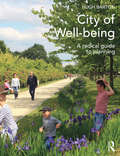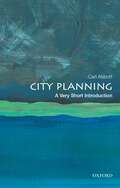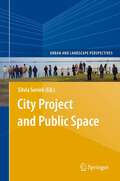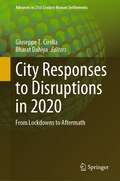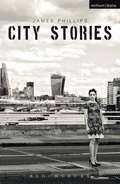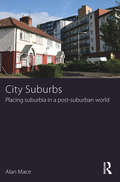- Table View
- List View
A City of Sadness (BFI Film Classics)
by Berenice ReynaudWinner of the Golden Lion in Venice in 1989, A City of Sadness introduced Western audiences to the richness of New Taiwanese Cinema. Its director, Hou Hsiao-hsien is now recognised as one of the most profoundly original auteurs in contemporary cinema. A City of Sadness revisits a painful episode in recent Taiwanese history, creating an elliptical and impressionistic picture of Chiang Kai-shek's takeover of the island after the defeat of his Kuomintang army by Mao Zedong. Taiwan's politics and the suffering of her inhabitants are invoked by Hou in the story of an extended family of four brothers. The first Taiwanese film shot in direct sound, A City of Sadness echoes the forgotten voices of ordinary people facing political repression. Berenice Reynaud deciphers the complex social and historical threads that combine in the film while analysing its aesthetics in the context of Hou's entire career. His journey from being a commercial director to becoming the famed master of long takes and painterly compositions is referred to the history of Taiwanese cinema and the philosophy of forms in Chinese art.
The City of Tomorrow: Sensors, Networks, Hackers, and the Future of Urban Life (PDF)
by Carlo Ratti Matthew ClaudelSince cities emerged ten thousand years ago, they have become one of the most impressive artifacts of humanity. But their evolution has been anything but linear—cities have gone through moments of radical change, turning points that redefine their very essence. In this book, a renowned architect and urban planner who studies the intersection of cities and technology argues that we are in such a moment. The authors explain some of the forces behind urban change and offer new visions of the many possibilities for tomorrow’s city. Pervasive digital systems that layer our cities are transforming urban life. The authors provide a front-row seat to this change. Their work at the MIT Senseable City Laboratory allows experimentation and implementation of a variety of urban initiatives and concepts, from assistive condition-monitoring bicycles to trash with embedded tracking sensors, from mobility to energy, from participation to production. They call for a new approach to envisioning cities: futurecraft, a symbiotic development of urban ideas by designers and the public. With such participation, we can collectively imagine, examine, choose, and shape the most desirable future of our cities.
The City of Tomorrow and Its Planning (Dover Architecture)
by Le Corbusier Frederick EtchellsIn this 1929 classic, the great architect Le Corbusier turned from the design of houses to the planning of cities, surveying urban problems and venturing bold new solutions. The book shocked and thrilled a world already deep in the throes of the modern age.Today it is revered as a work that, quite literally, helped to shape our world. Le Corbusier articulates concepts and ideas he would put to work in his city planning schemes for Algiers, São Paulo, Rio de Janeiro, Buenos Aires, Barcelona, Geneva, Stockholm, and Antwerp, as well as schemes for a variety of structures from a museum in Tokyo to the United Nations buildings. The influence it exerted on a new generation of architects is now legendary.The City of To-morrow and Its Planning characterizes European cities as a chaos of poor design, inadequate housing, and inefficient transportation that grew out of the unplanned jumble of medieval cities. Developing his thesis that a great modern city can only function on a basis of strict order, Le Corbusier presents two imposing schemes for urban reconstruction — the "Voisin" scheme for the center of Paris, and his more developed plans for the "City of Three Million Inhabitants," which envisioned, among other things, 60-story skyscrapers, set well apart, to house commercial activities, and residential housing grouped in great blocks of "villas."For those who live in cities as well as anyone interested in their planning, here is a probing survey of the problems of modern urban life and a master architect's stimulating vision of how they might be solved, enlivened by the innovative spirit and passionate creativity that distinguished all of Le Corbusier's work.
City of Well-being: A radical guide to planning
by Hugh BartonCity of Well-being provides a radical and holistic introduction to the science and art of town planning. It starts from the premise that the purpose of planning is the health, well-being and sustainable quality of life of people. Drawing on current and historic examples it offers inspiration, information and an integrated perspective which challenges all professions and decision-makers that affect the urban environment. It is both authoritative and readable, designed for students, practitioners, politicians and civil society. The science. Summarizing the most recent research, the book demonstrates the interrelationships between the huge issues of obesity, unhealthy lifestyles, inequality, mental illness, climate change and environmental quality. The radical implications for transport, housing, economic, social and energy policies are spelt out. The art and politics. The book examines how economic development really happens, and how spatial decisions reinforce or undermine good intentions. It searches for the creative strategies, urban forms and neighbourhood designs that can marry the ideal with the real. The relationship of planning and politics is tackled head-on, leading to conclusions about the role of planners, communities and development agencies in a pluralistic society. Healthy planning principles could provide a powerful logical motivation for all practitioners.
City of Well-being: A radical guide to planning
by Hugh BartonCity of Well-being provides a radical and holistic introduction to the science and art of town planning. It starts from the premise that the purpose of planning is the health, well-being and sustainable quality of life of people. Drawing on current and historic examples it offers inspiration, information and an integrated perspective which challenges all professions and decision-makers that affect the urban environment. It is both authoritative and readable, designed for students, practitioners, politicians and civil society. The science. Summarizing the most recent research, the book demonstrates the interrelationships between the huge issues of obesity, unhealthy lifestyles, inequality, mental illness, climate change and environmental quality. The radical implications for transport, housing, economic, social and energy policies are spelt out. The art and politics. The book examines how economic development really happens, and how spatial decisions reinforce or undermine good intentions. It searches for the creative strategies, urban forms and neighbourhood designs that can marry the ideal with the real. The relationship of planning and politics is tackled head-on, leading to conclusions about the role of planners, communities and development agencies in a pluralistic society. Healthy planning principles could provide a powerful logical motivation for all practitioners.
City on a Grid: How New York Became New York
by Gerard KoeppelWinner of the 2015 New York City Book AwardThe never-before-told story of the grid that ate ManhattanYou either love it or hate it, but nothing says New York like the street grid of Manhattan. This is its story.Praise for City on a Grid"The best account to date of the process by which an odd amalgamation of democracy and capitalism got written into New York's physical DNA."--New York Times Book Review"Intriguing...breezy and highly readable."--Wall Street Journal"City on a Grid tells the too little-known tale of how and why Manhattan came to be the waffle-board city we know."--The New Yorker"[An] expert investigation into what made the city special."--Publishers Weekly"A fun, fascinating, and accessible read for those curious enough to delve into the origins of an amazing city."--New York Journal of Books"Koeppel is the very best sort of writer for this sort of history."--Roanoke Times
City on a Grid: How New York Became New York
by Gerard KoeppelWinner of the 2015New York City Book AwardThe never-before-told story of the grid that ate ManhattanYou either love it or hate it, but nothing says New York like the street grid of Manhattan. This is its story.Praise for City on a Grid"The best account to date of the process by which an odd amalgamation of democracy and capitalism got written into New York's physical DNA."--New York Times Book Review"Intriguing...breezy and highly readable."--Wall Street Journal"City on a Grid tells the too little-known tale of how and why Manhattan came to be the waffle-board city we know."--The New Yorker"[An] expert investigation into what made the city special."--Publishers Weekly"A fun, fascinating, and accessible read for those curious enough to delve into the origins of an amazing city."--New York Journal of Books"Koeppel is the very best sort of writer for this sort of history."--Roanoke Times
City on a Hill: Urban Idealism in America from the Puritans to the Present
by Alex KriegerFrom the pilgrims to Las Vegas, hippie communes to the smart city, utopianism has shaped American landscapes. The Puritan small town was the New Jerusalem. Thomas Jefferson dreamed of rational farm grids. Reformers tackled slums through crusades of civic architecture. To understand American space, Alex Krieger looks to the drama of utopian ideals.
The City on Display: Architecture Festivals and the Urban Commons (Routledge Research in Architecture)
by Joel RobinsonThe City on Display: Architecture Festivals and the Urban Commons reflects on the biennials, triennials, and other festivals of architecture and design that have been held over the last two decades, as they expand and transform in response to the exigencies of ‘planetary urbanisation’. Joel Robinson examines the development of these large-scale, international, and perennial exhibitions as they address such challenges as urban regeneration, heritage preservation, climate change, and the migration crisis. Homing in on examples of festivals in Venice, Rotterdam, Oslo, Tallinn, Sharjah, Seoul, Shenzhen, and Hong Kong, the author describes how they alter the public spaces that host them, either through civic boosterism and gentrification, on the one hand, or through a reassertion of the urban commons and the right to the city, on the other hand. He attempts to thematise the architecture festival's relationship with the city and interrogate its potential as a forum for global debate about the emergencies of the urban condition. This book will be beneficial for students and academics of architecture and urbanism, and especially those who have an interest in how the city gets exhibited at such festivals and even reimagined as something other than it currently is.
The City on Display: Architecture Festivals and the Urban Commons (Routledge Research in Architecture)
by Joel RobinsonThe City on Display: Architecture Festivals and the Urban Commons reflects on the biennials, triennials, and other festivals of architecture and design that have been held over the last two decades, as they expand and transform in response to the exigencies of ‘planetary urbanisation’. Joel Robinson examines the development of these large-scale, international, and perennial exhibitions as they address such challenges as urban regeneration, heritage preservation, climate change, and the migration crisis. Homing in on examples of festivals in Venice, Rotterdam, Oslo, Tallinn, Sharjah, Seoul, Shenzhen, and Hong Kong, the author describes how they alter the public spaces that host them, either through civic boosterism and gentrification, on the one hand, or through a reassertion of the urban commons and the right to the city, on the other hand. He attempts to thematise the architecture festival's relationship with the city and interrogate its potential as a forum for global debate about the emergencies of the urban condition. This book will be beneficial for students and academics of architecture and urbanism, and especially those who have an interest in how the city gets exhibited at such festivals and even reimagined as something other than it currently is.
City Planning: A Very Short Introduction (Very Short Introductions)
by Carl AbbottCity planning is a practice and a profession. It is also a set of goals and--sometimes utopian--aspirations. Formal thought about the shaping of cities as physical spaces and social environments calls on the same range of disciplines and approaches that we use for understanding cities themselves, from art and literature through the social and natural sciences. Surrounding the core profession of city planning, also known as urban or town planning, are related fields of architecture, landscape design, engineering, geography, political science and policy, sociology, and social work. In addition, the legions of community and environmental activists influence debates and controversies within the field. This Very Short Introduction is organized around eight key aspects of city planning: street layout; congestion and decentralization; the response to suburbanization; the conservation and regeneration of older districts; cities as natural systems; cities and regions; social class and ethnicity; and disasters and resilience. The underlying assumption throughout is that decisions that we make today about cities and metropolitan regions are best understood as the continuation of past efforts to solve fundamental problems that have shifted and evolved over multiple generations. At its best, city planning utilizes technical tools to achieve goals set by community action and political debate. Carl Abbott's addition to Oxford's long-running Very Short Introduction series is a brief but concentrated look at past decisions about the management of urban growth and their effects on the creation of the twenty-first century city. ABOUT THE SERIES: The Very Short Introductions series from Oxford University Press contains hundreds of titles in almost every subject area. These pocket-sized books are the perfect way to get ahead in a new subject quickly. Our expert authors combine facts, analysis, perspective, new ideas, and enthusiasm to make interesting and challenging topics highly readable.
City Planning: A Very Short Introduction (Very Short Introductions)
by Carl AbbottCity planning is a practice and a profession. It is also a set of goals and--sometimes utopian--aspirations. Formal thought about the shaping of cities as physical spaces and social environments calls on the same range of disciplines and approaches that we use for understanding cities themselves, from art and literature through the social and natural sciences. Surrounding the core profession of city planning, also known as urban or town planning, are related fields of architecture, landscape design, engineering, geography, political science and policy, sociology, and social work. In addition, the legions of community and environmental activists influence debates and controversies within the field. This Very Short Introduction is organized around eight key aspects of city planning: street layout; congestion and decentralization; the response to suburbanization; the conservation and regeneration of older districts; cities as natural systems; cities and regions; social class and ethnicity; and disasters and resilience. The underlying assumption throughout is that decisions that we make today about cities and metropolitan regions are best understood as the continuation of past efforts to solve fundamental problems that have shifted and evolved over multiple generations. At its best, city planning utilizes technical tools to achieve goals set by community action and political debate. Carl Abbott's addition to Oxford's long-running Very Short Introduction series is a brief but concentrated look at past decisions about the management of urban growth and their effects on the creation of the twenty-first century city. ABOUT THE SERIES: The Very Short Introductions series from Oxford University Press contains hundreds of titles in almost every subject area. These pocket-sized books are the perfect way to get ahead in a new subject quickly. Our expert authors combine facts, analysis, perspective, new ideas, and enthusiasm to make interesting and challenging topics highly readable.
City Project and Public Space (Urban and Landscape Perspectives #14)
by Silvia SerreliThe book aims at nurturing theoretic reflection on the city and the territory and working out and applying methods and techniques for improving our physical and social landscapes. The main issue is developed around the projectual dimension, with the objective of visualising both the city and the territory from a particular viewpoint, which singles out the territorial dimension as the city’s space of communication and negotiation. Issues that characterise the dynamics of city development will be faced, such as the new, fresh relations between urban societies and physical space, the right to the city, urban equity, the project for the physical city as a means to reveal civitas, signs of new social cohesiveness, the sense of contemporary public space and the sustainability of urban development. Authors have been invited to explore topics that feature a pluralism of disciplinary contributions studying formal and informal practices on the project for the city and seeking conceptual and operative categories capable of understanding and facing the problems inherent in the profound transformations of contemporary urban landscapes.
City Publics: The (Dis)enchantments of Urban Encounters (Questioning Cities)
by Sophie WatsonSome cities have grown into mega cities and some into uncontrolled sprawl; others have seen their centres decline with populations moving to the suburbs. In such times, questions of the public realm and public space in cities warrant even greater attention than previously received. Concerned with the borders and boundaries, constraints and limits on accepting, acknowledging and celebrating difference in public, Sophie Watson, through ethnographic studies, interrogates how difference is negotiated and performed. Focusing on spaces where to outside observers tension is relatively absent or invisible, Watson also reveals how the boundaries between the public and private are being negotiated and redrawn, and how public and private spaces are mutually constitutive. Through her investigation of the more ordinary and less dramatic forms of encounter and contestation in the city, Watson is able to conceive an urban public realm and urban public space that is heterogeneous and potentially progressive. With numerous photographs and drawings City Publics not only throws new light on encounters with others in public space, but also destabilizes dominant, sometimes simplistic, universalized accounts and helps us re-imagine urban public space as a site of potentiality, difference, and enchanted encounters.
City Publics: The (Dis)enchantments of Urban Encounters (Questioning Cities)
by Sophie WatsonSome cities have grown into mega cities and some into uncontrolled sprawl; others have seen their centres decline with populations moving to the suburbs. In such times, questions of the public realm and public space in cities warrant even greater attention than previously received. Concerned with the borders and boundaries, constraints and limits on accepting, acknowledging and celebrating difference in public, Sophie Watson, through ethnographic studies, interrogates how difference is negotiated and performed. Focusing on spaces where to outside observers tension is relatively absent or invisible, Watson also reveals how the boundaries between the public and private are being negotiated and redrawn, and how public and private spaces are mutually constitutive. Through her investigation of the more ordinary and less dramatic forms of encounter and contestation in the city, Watson is able to conceive an urban public realm and urban public space that is heterogeneous and potentially progressive. With numerous photographs and drawings City Publics not only throws new light on encounters with others in public space, but also destabilizes dominant, sometimes simplistic, universalized accounts and helps us re-imagine urban public space as a site of potentiality, difference, and enchanted encounters.
The City Reader (Routledge Urban Reader Series)
by Richard T. LeGates Frederic StoutThe sixth edition of the highly successful The City Reader juxtaposes the very best classic and contemporary writings on the city to provide the comprehensive mapping of the terrain of Urban Studies and Planning old and new. The City Reader is the anchor volume in the Routledge Urban Reader Series and is now integrated with all ten other titles in the series. This edition has been extensively updated and expanded to reflect the latest thinking in each of the disciplinary areas included and in topical areas such as compact cities, urban history, place making, sustainable urban development, globalization, cities and climate change, the world city network, the impact of technology on cities, resilient cities, cities in Africa and the Middle East, and urban theory. The new edition places greater emphasis on cities in the developing world, globalization and the global city system of the future. The plate sections have been revised and updated. Sixty generous selections are included: forty-four from the fifth edition, and sixteen new selections, including three newly written exclusively for The City Reader. The sixth edition keeps classic writings by authors such as Ebenezer Howard, Ernest W. Burgess, LeCorbusier, Lewis Mumford, Jane Jacobs, and Louis Wirth, as well as the best contemporary writings of, among others, Peter Hall, Manuel Castells, David Harvey, Saskia Sassen, and Kenneth Jackson. In addition to newly commissioned selections by Yasser Elshestawy, Peter Taylor, and Lawrence Vale, new selections in the sixth edition include writings by Aristotle, Peter Calthorpe, Alberto Camarillo, Filip DeBoech, Edward Glaeser, David Owen, Henri Pirenne, The Project for Public Spaces, Jonas Rabinovich and Joseph Lietman, Doug Saunders, and Bish Sanyal. The anthology features general and section introductions as well as individual introductions to the selected articles introducing the authors, providing context, relating the selection to other selection, and providing a bibliography for further study. The sixth edition includes fifty plates in four plate sections, substantially revised from the fifth edition.
The City Reader (Routledge Urban Reader Series)
by Richard T. LeGates Frederic StoutThe sixth edition of the highly successful The City Reader juxtaposes the very best classic and contemporary writings on the city to provide the comprehensive mapping of the terrain of Urban Studies and Planning old and new. The City Reader is the anchor volume in the Routledge Urban Reader Series and is now integrated with all ten other titles in the series. This edition has been extensively updated and expanded to reflect the latest thinking in each of the disciplinary areas included and in topical areas such as compact cities, urban history, place making, sustainable urban development, globalization, cities and climate change, the world city network, the impact of technology on cities, resilient cities, cities in Africa and the Middle East, and urban theory. The new edition places greater emphasis on cities in the developing world, globalization and the global city system of the future. The plate sections have been revised and updated. Sixty generous selections are included: forty-four from the fifth edition, and sixteen new selections, including three newly written exclusively for The City Reader. The sixth edition keeps classic writings by authors such as Ebenezer Howard, Ernest W. Burgess, LeCorbusier, Lewis Mumford, Jane Jacobs, and Louis Wirth, as well as the best contemporary writings of, among others, Peter Hall, Manuel Castells, David Harvey, Saskia Sassen, and Kenneth Jackson. In addition to newly commissioned selections by Yasser Elshestawy, Peter Taylor, and Lawrence Vale, new selections in the sixth edition include writings by Aristotle, Peter Calthorpe, Alberto Camarillo, Filip DeBoech, Edward Glaeser, David Owen, Henri Pirenne, The Project for Public Spaces, Jonas Rabinovich and Joseph Lietman, Doug Saunders, and Bish Sanyal. The anthology features general and section introductions as well as individual introductions to the selected articles introducing the authors, providing context, relating the selection to other selection, and providing a bibliography for further study. The sixth edition includes fifty plates in four plate sections, substantially revised from the fifth edition.
The City Reader (Routledge Urban Reader Series)
by Richard T. LeGates Frederic StoutThe seventh edition of the highly successful The City Reader juxtaposes the very best classic and contemporary writings on the city. Sixty-three selections are included: forty-five from the sixth edition and eighteen new selections, including three newly written exclusively for The City Reader. The anthology features a Prologue essay on "How to Study Cities", eight part introductions as well as individual introductions to each of the selected articles. The new edition has been extensively updated and expanded to reflect the latest thinking in each of the disciplinary and topical areas included, such as sustainable urban development, globalization, the impact of technology on cities, resilient cities, and urban theory. The seventh edition places greater emphasis on cities in the developing world, the global city system, and the future of cities in the digital transformation age. While retaining classic writings from authors such as Lewis Mumford, Jane Jacobs, and Louis Wirth, this edition also includes the best contemporary writings of, among others, Peter Hall, Manuel Castells, and Saskia Sassen. New material has been added on compact cities, urban history, placemaking, climate change, the world city network, smart cities, the new social exclusion, ordinary cities, gentrification, gender perspectives, regime theory, comparative urbanization, and the impact of technology on cities. Bibliographic material has been completely updated and strengthened so that the seventh edition can serve as a reference volume orienting faculty and students to the most important writings of all the key topics in urban studies and planning. The City Reader provides the comprehensive mapping of the terrain of Urban Studies, old and new. It is essential reading for anyone interested in studying cities and city life.
The City Reader (Routledge Urban Reader Series)
by Richard T. LeGates Frederic StoutThe seventh edition of the highly successful The City Reader juxtaposes the very best classic and contemporary writings on the city. Sixty-three selections are included: forty-five from the sixth edition and eighteen new selections, including three newly written exclusively for The City Reader. The anthology features a Prologue essay on "How to Study Cities", eight part introductions as well as individual introductions to each of the selected articles. The new edition has been extensively updated and expanded to reflect the latest thinking in each of the disciplinary and topical areas included, such as sustainable urban development, globalization, the impact of technology on cities, resilient cities, and urban theory. The seventh edition places greater emphasis on cities in the developing world, the global city system, and the future of cities in the digital transformation age. While retaining classic writings from authors such as Lewis Mumford, Jane Jacobs, and Louis Wirth, this edition also includes the best contemporary writings of, among others, Peter Hall, Manuel Castells, and Saskia Sassen. New material has been added on compact cities, urban history, placemaking, climate change, the world city network, smart cities, the new social exclusion, ordinary cities, gentrification, gender perspectives, regime theory, comparative urbanization, and the impact of technology on cities. Bibliographic material has been completely updated and strengthened so that the seventh edition can serve as a reference volume orienting faculty and students to the most important writings of all the key topics in urban studies and planning. The City Reader provides the comprehensive mapping of the terrain of Urban Studies, old and new. It is essential reading for anyone interested in studying cities and city life.
City Responses to Disruptions in 2020: From Lockdowns to Aftermath (Advances in 21st Century Human Settlements)
by Giuseppe T. Cirella Bharat DahiyaThis book presents the integrating of economics and urban geography to create a framework of cooperation around the idea of urban economic stability. It explores these disciplines through the economic lens and creates a collaborative environment for addressing the global challenges caused by the COVID-19 pandemic and future global shocks. Environmental advocates and proponents of economic growth are increasingly at odds—having looked at the economic impact of the decline of the environment as well as the environmental loss that occurs with unchecked growth and urbanization. The outbreak of the COVID-19 pandemic changed the global scene. The world shook in its foundations, as a number of countries’ lockdown affected not only the global economy but also society and the environment. The global community has seen the negative impact of COVID-19 on our economies. There have been steep declines in gross domestic product, job losses have been in the millions, and people have seen their incomes fall. An unplanned shutdown has taken its toll and has been a shock to the economies of the world. Past shocks and how they have impacted urban economies as well as for how long are core to bettering our understanding of present and future urban economic change. The underlying economic factors that make a shock more damaging to certain economies or industries, as well as understanding these vulnerabilities, help entities recover from economic shocks and allow them to better understand how impacts on individual businesses can be implemented. The pandemic revealed the need to adopt a global development approach, taking into consideration four dimensions: global value chains, debt, digitalization, and the environment. Topics related to the causation and lockdown are explored through a number of case studies from around the world.
City Spaces - Tourist Places
by Bruce Hayllar Tony Griffin Deborah EdwardsOver the last decade, commentaries and research on urban tourism precincts have predominantly focused on: their role in the tourism attractions mix; their physical and functional forms; their economic significance; their role as a catalyst for urban renewal; their evolution and associated development processes; and, perhaps more broadly, their role, locality and function within the context of urban planning. City Spaces – Tourist Places both consolidates and develops the extant knowledge of urban tourism precincts into a coherent research driven contemporary work. It revisits and examines the foundational literature but, more importantly, engages with aspects of precinct development that have previously been either underdeveloped or received only limited consideration, such as the psychological and socio-cultural dimensions of the precinct experience. Written by an international team of contributors it provides the reader with:* A comprehensive analysis of foundational theory and cutting-edge advances in the knowledge of the precinct phenomenon * An examination of previously underdeveloped topics and themes based on contemporary and ground-breaking research * Typological and theoretical frameworks in which to locate precinct form, function and experienceBrilliantly edited to ensure theoretical continuity and coherence City Spaces – Tourist Places is vital reading for anyone involved in the study or planning of urban tourism precincts.
City Spaces - Tourist Places
by Bruce Hayllar Tony Griffin Deborah EdwardsOver the last decade, commentaries and research on urban tourism precincts have predominantly focused on: their role in the tourism attractions mix; their physical and functional forms; their economic significance; their role as a catalyst for urban renewal; their evolution and associated development processes; and, perhaps more broadly, their role, locality and function within the context of urban planning. City Spaces – Tourist Places both consolidates and develops the extant knowledge of urban tourism precincts into a coherent research driven contemporary work. It revisits and examines the foundational literature but, more importantly, engages with aspects of precinct development that have previously been either underdeveloped or received only limited consideration, such as the psychological and socio-cultural dimensions of the precinct experience. Written by an international team of contributors it provides the reader with:* A comprehensive analysis of foundational theory and cutting-edge advances in the knowledge of the precinct phenomenon * An examination of previously underdeveloped topics and themes based on contemporary and ground-breaking research * Typological and theoretical frameworks in which to locate precinct form, function and experienceBrilliantly edited to ensure theoretical continuity and coherence City Spaces – Tourist Places is vital reading for anyone involved in the study or planning of urban tourism precincts.
City Stories (Modern Plays)
by James PhillipsWhat happens when someone tells you that you're the answer to the riddle of life? What happens when a stranger in Starbucks gives you something that will change your world forever? What happens if the world starts to fall asleep, hour by hour?City Stories is a new type of cabaret drama, a sequence of interwoven love stories, and a love-letter to London. Composed up of five discrete yet interwoven stories, each taking the form of a monologue or duologue, and performed with specifically composed songs, City Stories looks at a variety of experiences of love and loss via a range of people living in the UK's capital. Elegantly written and beautifully constructed, these pieces look at the varieties of love and how it might save us, showing James Phillips's writing at his very best. City Stories received its world premiere at St James's Theatre, London, in 2013 and has since gone on to establish a year-long residency at the theatre.
City Stories (Modern Plays)
by James PhillipsWhat happens when someone tells you that you're the answer to the riddle of life? What happens when a stranger in Starbucks gives you something that will change your world forever? What happens if the world starts to fall asleep, hour by hour?City Stories is a new type of cabaret drama, a sequence of interwoven love stories, and a love-letter to London. Composed up of five discrete yet interwoven stories, each taking the form of a monologue or duologue, and performed with specifically composed songs, City Stories looks at a variety of experiences of love and loss via a range of people living in the UK's capital. Elegantly written and beautifully constructed, these pieces look at the varieties of love and how it might save us, showing James Phillips's writing at his very best. City Stories received its world premiere at St James's Theatre, London, in 2013 and has since gone on to establish a year-long residency at the theatre.
City Suburbs: Placing suburbia in a post-suburban world
by Alan MaceThe majority of the world’s population is now urban, and for most this will mean a life lived in the suburbs. City Suburbs considers contemporary Anglo-American suburbia, drawing on research in outer London it looks at life on the edge of a world city from the perspective of residents. Interpreted through Bourdieu’s theory of practice it argues that the contemporary suburban life is one where place and participation are, in combination, strong determinants of the suburban experience. From this perspective suburbia is better seen as a process, an on-going practice of the suburban which is influenced but not determined by the history of suburban development. How residents engage with the city and the legacy of particular places combine powerfully to produce very different experiences across outer London. In some cases suburban residents are able to combine the benefits of the city and their residential location to their advantage but in marginal middle-class areas the relationship with the city is more circumspect as the city represents more threat than opportunity. The importance of this relational experience with the city informs a call to integrate more fully the suburbs into studies of the city.



